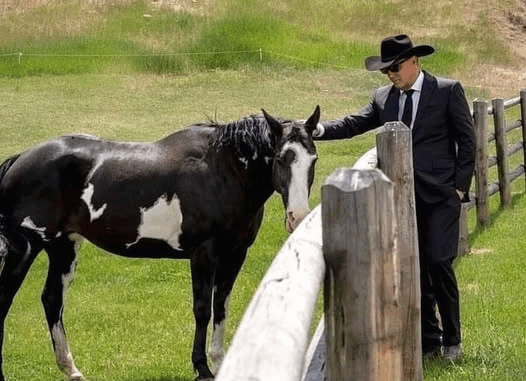
The spotlight on Yellowstone isn’t always about its breathtaking landscapes or gritty storylines. This time, the drama unfolded off-screen when animal rights organization PETA accused the production of using a real cow carcass for a disturbing scene. The allegation sparked a heated ethical debate, pulling in public opinion, cast responses, and questions about Hollywood’s commitment to humane filming practices.
1. What Exactly Did PETA Claim?
PETA alleged that during the filming of Yellowstone, the crew used an actual dead cow, reportedly in a state of decomposition. According to the group, the set smelled of rotting flesh, and the imagery in the scene crossed the line from realism into outright exploitation. They condemned it as an unnecessary and harmful practice that disrespected both animals and audiences.
2. Why This Scene Triggered Outrage
Sure, Yellowstone is known for its raw, unfiltered portrayal of ranch life. But realism has limits. PETA argued that simulating the scene with prosthetics, special effects, or CGI would have been equally effective — without using a real animal body. For animal welfare advocates, this wasn’t about creative freedom; it was about setting industry standards for humane treatment.
3. Sam Elliott’s Role in the Controversy
While the allegations were directed at the production, veteran actor Sam Elliott became part of the conversation due to his outspoken nature and close association with Western storytelling. Critics expected him to take a stance, but his comments instead stirred additional debate, as some felt they downplayed the seriousness of the animal cruelty concerns.
4. How the Production Responded
The Yellowstone team defended the scene, insisting it was a realistic portrayal of ranch life and not meant to sensationalize cruelty. They argued that the carcass was sourced ethically — though details remained vague. This response didn’t sit well with PETA, who claimed there was no “ethical” way to justify using a real dead animal for entertainment.
5. Hollywood’s History with Live Animals
This isn’t the first time Hollywood has been accused of questionable animal treatment. From early Westerns to large-scale battle films, live animals have often been subjected to stressful or dangerous conditions. In recent years, however, public awareness and strict animal welfare guidelines have pushed the industry toward more humane practices.
6. The Realism vs. Responsibility Debate
For directors, authenticity can be a powerful storytelling tool. But at what cost? Using a real carcass might create a shocking visual, but it raises a bigger question: Should entertainment ever come at the expense of ethical standards? It’s a debate where art, morality, and audience sensitivity collide.
7. Audience Reactions: Divided Opinions
Some fans defended the show, claiming that ranch life isn’t sanitized and the scene reflected reality. Others were disgusted, arguing that art should not require the use of real dead animals. The division highlighted a growing trend: audiences increasingly expect ethical responsibility from entertainment producers.
8. PETA’s Broader Campaign Against Yellowstone
This wasn’t PETA’s only clash with Yellowstone. The group has previously criticized the series for glamorizing rodeo culture, which they argue involves inherent animal suffering. By targeting high-profile productions, PETA aims to push for industry-wide changes.
9. Could CGI Have Solved This?
The irony? Modern filmmaking technology is advanced enough to recreate realistic animal scenes without ever using a live or dead animal. From prosthetic replicas to hyper-realistic CGI, alternatives are available — and widely used in other productions. The refusal to adopt these methods raises questions about priorities.
10. The Ethics of “Found” Animal Bodies
Some argue that using an animal already dead from natural causes is different from harming one for a scene. But animal rights advocates maintain that even “found” bodies can be exploited in ways that are disrespectful and unnecessary. The nuance lies in intent — and perception.
11. Impact on Sam Elliott’s Public Image
While Sam Elliott wasn’t directly involved in the scene’s production, his perceived indifference or minimization of the issue caused some fans to view him differently. In the age of social media, silence — or the wrong tone — can be just as damaging as active participation.
12. Animal Welfare Rules in Film and TV
In the U.S., the American Humane Association monitors many productions, granting the “No Animals Were Harmed” certification. If Yellowstone did use a real carcass, it raises the question: Was this scene monitored? And if so, how did it meet the necessary standards?
13. The PR Fallout for Yellowstone
Whether justified or not, the controversy added a layer of negative publicity to a show that thrives on authenticity. Public perception matters — and when a respected brand faces ethical backlash, it risks alienating part of its audience.
14. The Future of Animal Portrayals in Media
With animal rights advocacy growing stronger, productions may have to adopt stricter guidelines. Expect to see more reliance on CGI, animatronics, and careful editing to avoid any suggestion of animal exploitation.
15. The Bigger Picture
This debate isn’t just about one scene. It’s about where we draw the line between artistic integrity and ethical responsibility — and who gets to decide that line.
Conclusion
The Yellowstone cow carcass controversy is more than a footnote in Hollywood gossip. It’s a reminder that creative choices carry ethical weight. Whether you side with PETA or the production, one thing is clear: the conversation about how animals are treated on set isn’t going away. And maybe it shouldn’t.
FAQs
1. Did Yellowstone confirm using a real cow carcass?
The production acknowledged the scene’s realism but did not provide full details about sourcing.
2. Was Sam Elliott directly involved in the scene?
No, but his comments about the controversy fueled additional debate.
3. What alternatives could have been used instead of a real carcass?
CGI, prosthetics, and animatronics are all viable and humane options.
4. Has PETA targeted other TV shows before?
Yes, PETA frequently challenges productions they believe exploit animals.
5. Could this controversy affect Yellowstone’s future seasons?
While unlikely to halt production, it may influence how animal scenes are handled in the future
